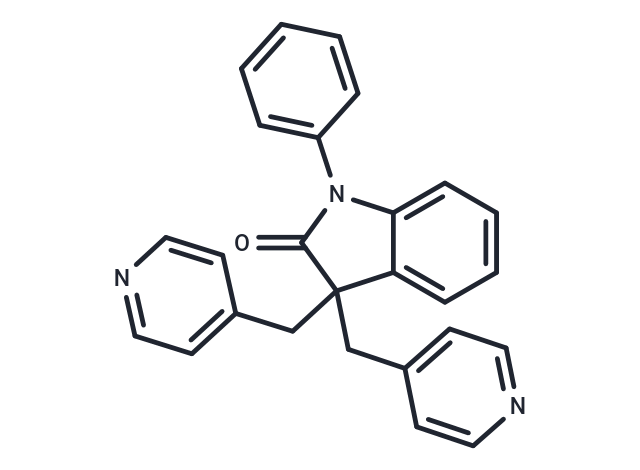Shopping Cart
- Remove All
 Your shopping cart is currently empty
Your shopping cart is currently empty

Linopirdine (DuP 996) is a TRPV1 agonist. Linopirdine is an orally active and selective M-type K+ current (IM; Kv7; KCNQ Channels) inhibitor (IC50: 2.4 μM). Linopirdine is a cognitive enhancer. It acts by stimulating release of acetylcholine and other neurotransmitters.Linopirdine is a putative cognition-enhancing drug that increases acetylcholine release in rat brain tissue.

| Pack Size | Price | Availability | Quantity |
|---|---|---|---|
| 1 mg | $36 | In Stock | |
| 2 mg | $51 | In Stock | |
| 5 mg | $80 | In Stock | |
| 10 mg | $128 | In Stock | |
| 25 mg | $239 | In Stock | |
| 50 mg | $413 | In Stock | |
| 100 mg | $590 | In Stock | |
| 200 mg | $853 | In Stock | |
| 500 mg | $1,270 | In Stock | |
| 1 mL x 10 mM (in DMSO) | $89 | In Stock |
| Description | Linopirdine (DuP 996) is a TRPV1 agonist. Linopirdine is an orally active and selective M-type K+ current (IM; Kv7; KCNQ Channels) inhibitor (IC50: 2.4 μM). Linopirdine is a cognitive enhancer. It acts by stimulating release of acetylcholine and other neurotransmitters.Linopirdine is a putative cognition-enhancing drug that increases acetylcholine release in rat brain tissue. |
| Targets&IC50 | K+ current, M-type:2.4 μM |
| In vitro | Linopirdine is a well known blocker of voltage-gated potassium channels from the Kv7 (or KCNQ) family that generate the so called M current in mammalian neurons. Kv7 subunits are also expressed in pain-sensing neurons in dorsal root ganglia, in which they modulate neuronal excitability. Linopirdine acts as an agonist of TRPV1 (transient receptor potential vanilloid type 1), another ion channel expressed in nociceptors and involved in pain signaling. Linopirdine induces increases in intracellular calcium concentration in human embryonic kidney 293 (HEK293) cells expressing TRPV1, but not TRPA1 and TRPM8 or in wild-type HEK293 cells. Linopirdine also activates an inward current in TRPV1-expressing HEK293 cells that is almost completely blocked by the selective TRPV1 antagonist capsazepine. At low concentrations linopirdine sensitizes both recombinant and native TRPV1 channels to heat, in a manner that is not prevented by the Kv7-channel opener flupirtine. Linopirdine exerts an excitatory action on mammalian nociceptors not only through inhibition of the M current but also through activation of the capsaicin receptor TRPV1[4]. |
| In vivo | Linopirdine (i.v.; 0.1-6 mg/kg; increasing doses) transiently (10-15 min) and dose-dependently enhances MAP by up to 15%[2]. |
| Alias | DuP 996 |
| Molecular Weight | 391.46 |
| Formula | C26H21N3O |
| Cas No. | 105431-72-9 |
| Smiles | O=C1N(c2ccccc2C1(Cc1ccncc1)Cc1ccncc1)c1ccccc1 |
| Relative Density. | 1.255 g/cm3 |
| Storage | Powder: -20°C for 3 years | In solvent: -80°C for 1 year | Shipping with blue ice. | |||||||||||||||||||||||||||||||||||
| Solubility Information | DMSO: 110 mg/mL (281 mM), Sonication is recommended. | |||||||||||||||||||||||||||||||||||
Solution Preparation Table | ||||||||||||||||||||||||||||||||||||
DMSO
| ||||||||||||||||||||||||||||||||||||

Copyright © 2015-2024 TargetMol Chemicals Inc. All Rights Reserved.